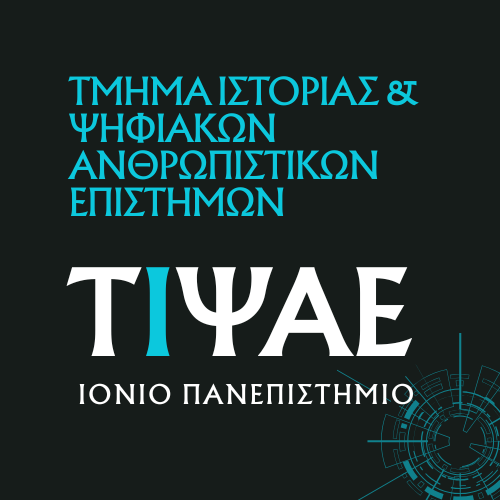HISTORY OF ART: FROM THE RENAISSANCE TO THE 20TH CENTURY
Teaching Staff: Palioura Mirka
Course Code: ΙΤΕ101
Course Type: Compulsory
Course Level: Undergraduate
Course Language: Greek
Delivery method: Lectures
Semester: 6th
ECTS: 5
Curricula: Curriculum in History up to 2024-25, Curriculum in History and Digital Humanities from 2025
This module offers a first survey-like acquaintance with European painting, sculpture and architecture of the Early Modern period and the first century Modern times. It is based on the presentation of selected artworks (ca. 60) which represent the technical and aesthetic developments from the Early Renaissance to the World War I. Through these artworks one can pinpoint the complex interrelations between art and history, which change significantly throughout the period in question. It is meant to be an introduction to Art History offering both general knowledge on specific manifestations of cultural history and an induction to the specific methods and the overall scope of the historical study of fine art production between 1400 and 1914.
This module aims at helping the students to become familiar with 10 – 12 typical artworks of each century and to learn how to analyze them through the most widely used methods of art history (formal analysis, iconography-iconology, historical/social analysis, semiotic analysis). With the successful fulfillment of these requirements the students should be able to recognize and categorize the art work (by period, style, place of production) and to comment upon them by using the aforementioned methods and the links they forge with their developing knowledge in the historical context. Furthermore, they should have acquired general knowledge on the life, personality, education, art preferences and collaborations of major artists, as well as their views about important aesthetic, social, economic and political issues.
Week 1:
- Discussion on the meaning of the term “history of art”
- Discussion of the meaning of the term “Renaissance”
- Discussion on the formative traits of art and culture since the 1400s (eg. relations with antiquity, religion and the idea of the autonomous artist)
- Survey of the basic traits of Renaissance art vs the art of the medieval “renaissances”
Week 2: Moving towards naturalism and its different routes (classical vs international gothic style)
Gioto di Bondone, Papal palace of Avignon, illustrated manuscripts by the Limbourg Bros, Masaccio.
Week 3: Filippo Bruneleschi – Donatello – Jan van Eyck: from perspective to oil painting.
Week 4: Combining the two studies in the ambitious court of the Medicis (Paolo Uccello, Benozzo Gozzoli, Botticelli).
Week 5: Depiction of ruins, the theoretical treatises and their use in the Italian Art (Mantegna, Alberti). Humanistic influences in Northern Europe (Dürer).
Week 6: High Renaissance in Florence and Rome (da Vinci, Raphael, Michelangelo)
Week 7: The turmoil of the 1517-1600 period and their impact on art (Bosch, H. Holbein, Mannerism in Emilia Romagna).
Week 8: Mannerism in the Habsburg territories (Brueghel – El Greco). The Art of Venice (1480-1580). Art in Catholic Europe – The Baroque of the Anti-Reformation.
Week 9: Baroque and absolute Monarchy (Rubens, van Dyck, Velasquez). Art in the Netherlands during the Golden Age (Rembrandt, genre painting, Vermeer).
Week 10: Aspects of classicism between 1600 and 1800 (the botega of the Caracci, Pousin, Lorrain and the rise of the academies).
Week 11: Europearan architecture (17th-18th century). Versailles, Louvre, Wieskirche, St. Paul’s Cathedral). Genre and portrait painters of the 18th century (Watteau, Boucher, Chardin, Greuze, Hogarth, Reynolds, Gainsborough).
Week 12: Neoclassicism – Romanticism – Realism (France, England, Germany).
Week 13: The art of the 1850 – 1914 period, with an emphasis on the wider post-impressionist movement and its modernist implications.
- Belting, H. et al. (επιμ.), Εισαγωγή στην Ιστορία της Τέχνης. Θεσσαλονίκη, 1995
- Gombrich, E., Το Χρονικό της Τέχνης. Αθήνα, 1994
- Λαμπράκη-Πλάκα, Μ., Ιταλική Αναγέννηση: τέχνη και κοινωνία, τέχνη και αρχαιότητα. Αθήνα, 2004
- Puttfarken, T., The discovery of the pictorial composition: theories of visual order in painting (1400-1800). New Haven, Conn, 2000
- Wölfflin, H., Βασικές έννοιες της ιστορίας της τέχνης. Αθήνα, 2006
- Χαραλαμπίδης, Α., Μπαρόκ. Θεσσαλονίκη, 2017
- Χρήστου, Χ., Η ευρωπαϊκή ζωγραφική του 20ου αιώνα. Θεσσαλονίκη, 1985.
Lectures – Presentations – Exercise on visual and historical analysis.
Final (written) examination – contribution to presentations and exercises.
Back



